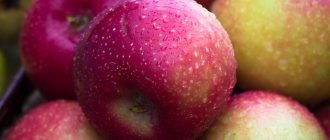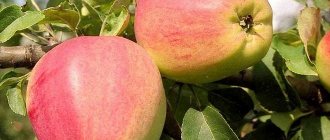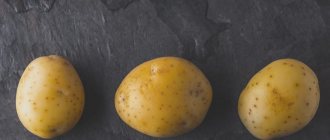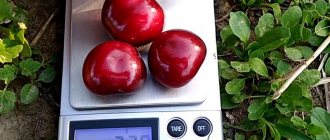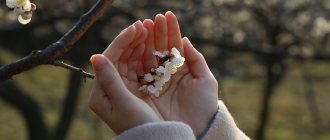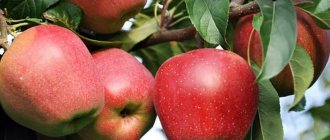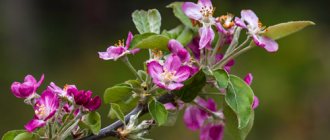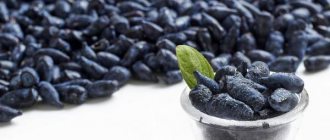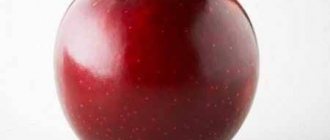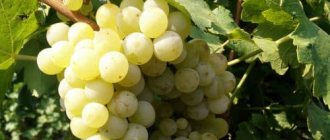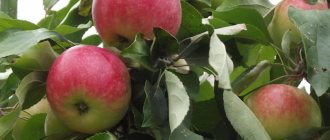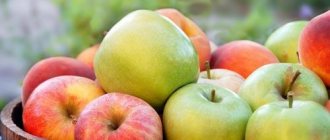Description
Zhigulevskoye apple trees are grown in private gardens and even on an industrial scale. They are even suitable for growing in intensive gardens.
The plant is of medium height, but produces a fairly high yield. The tree itself prefers to grow in warm places, because it is not highly resistant to low temperatures. The apple tree must also be protected from codling moths and fungal diseases.
Variety characteristics
The Zhigulevskoye apple tree is distinguished by its regular structure. It has powerful skeletal branches, beautiful leaves and large flowers. But the main advantage and feature of this variety is still its fruits. They are large, can reach a weight of 200 grams. The skin color is yellow-green, but they are covered with a red blush and an oily coating. The fruits are beautiful, round, with a thick stalk.
Tasting assessment
The taste qualities of the Zhigulevskoe variety are so high that I would like to highlight them separately. The pulp is creamy, coarse-grained and very juicy, the skin is dense. The taste of the fruit is characterized as very sweet, with a slight sourness, which will add sophistication. Despite all their sweetness, the fruits are low-calorie, because they contain 87% water.
Self-fertility
The variety needs pollinating neighbors, because it is not self-fertile. Trees that will be good pollinators should grow in the garden or nearby, no more than 50 m.
The best autumn varieties are perfect for this:
- Anise gray;
- Kutuzovets;
- Antonovka vulgare;
- Kuibyshevskoe;
- Spartacus.
Only with high-quality cross-pollination will the Zhigulevskoye apple tree variety bear fruit well.
Tree height
The Zhigulevskoe apple tree can be considered medium-sized or semi-dwarf. Its height reaches 3 meters, no more. And although the yield is slightly lower than that of tall individuals, the compact size will allow planting to be denser, and therefore compensates for this disadvantage. The normal lifespan of such trees is 40 years.
Apple tree Zhigulevskoe.
Crown width
The crown of the apple tree is not thickened, the branches are quite sparse, rushing upward. Thanks to their structure, the sun's rays penetrate well into the crown to all the fruits and saturate them with taste.
At the same time, it lends itself well to shaping:
- massive and stable wide-pyramidal;
- neat, highly rounded, for small areas.
This structure allows you to reduce the time and effort required for pruning.
Root system
The roots of this variety must be healthy and resilient when planting for the plant to fully develop. They do not tolerate excess moisture, so it is better not to plant the tree in places where there is accumulation of moisture and close groundwater.
Winter hardiness
The apple tree is not particularly frost-resistant. She experiences stress due to temperature changes and thaws. The tree does not adapt well to winter frosts and suffers from the cold. Therefore, in conditions with extreme temperatures, Zhigulevskoye needs shelter and spring pruning.
Beginning of fruiting
Fruiting usually begins 4–5 years after planting, but it may shift slightly, because it all depends on a number of factors:
- rootstock varieties;
- climatic conditions;
- correct agricultural technology.
The fruit of the Zhigulevskoe apple tree.
But the sooner the tree begins to bear fruit, the sooner this period will end.
Flowering time
Flowering begins in mid-May, in some areas at the end. It is because of early flowering that the tree may suffer from May frosts.
Fruit ripening
The Zhigulevskoye apple tree variety is autumn or even late autumn. Fruit harvest, depending on the region of growth, may vary from mid-August to the end of September.
However, collection can be carried out in two stages:
- 2–3 weeks before full ripening;
- during consumer maturity, which occurs at the end of September.
Apples that are picked before ripeness have a longer shelf life. The variety is distinguished by the fact that it does not have a tendency to fall off. This is a huge plus, as part of the harvest is not lost.
Fruit storage
Without loss of taste, apples can be stored for about three months. However, this is only possible if you meet certain requirements:
- remove fruits from apple trees in dry weather;
- do not injure the skin and stalk;
- sort by size, do not store intact and damaged ones together;
- provide a temperature from 0 to +4 degrees.
Under these conditions, within three weeks the fruits will acquire the full spectrum of taste.
Productivity
The tree has an enviable and high yield. A typical tree can produce about 250 kg of fruit per season. Taking into account the fact that fruiting is annual, and the apple tree itself is of medium size – this is quite an impressive figure. Cyclicity is observed only in old trees of this variety.
Zhigulevskoe apple harvest.
Productivity
According to the timing of harvest ripening, the apple tree is a late summer tree, producing fruits in late August or early September. The awakening of the buds is excellent, flowering begins early, so sometimes the fruit buds are injured from recurrent frosts.
Precociousness is assessed as moderate. Stable fruiting begins at about the 6th year of the tree’s life; you can get about 250 kilograms of harvest (relevant for tall apple trees).
If the plant is medium-sized, up to 3 meters, then you can wait for apples for 4 years, and semi-dwarf specimens begin to bear fruit already from 3 years. Dwarf individuals allow you to collect about 10 kilograms of apples already 2 years after planting.
Small dog breeds. Description, features, names and types of small dogs
The best time to harvest is in early September.
Features of planting and care
Although the variety is not particularly picky, there are a few care considerations to consider.
Deadlines
Planting can be done in autumn or spring. Both options have their place, but they also have their own nuances. It is worth taking a closer look at both methods.
Spring
Spring planting is preferable for northern regions. Throughout the summer, before the onset of frost, the seedlings will get stronger, and this will help them take root. Planting dates can vary from the last weeks of April to early May.
Autumn
Autumn planting will be especially advantageous for regions that do not experience severe frosts during the cold season. Over the winter, the tree will quickly settle down and become stronger, so fruiting begins a year earlier.
Technology
Planting a seedling of the Zhigulevskoye variety is no different from others. It is necessary to prepare the planting hole in advance, lay drainage at the bottom, sprinkle with soil, add fertilizer and make a hill. After the soil has settled, which will take approximately 2–3 weeks, you can begin planting.
Accommodation on site
The Zhigulevskoe apple tree needs cross-pollination, so they need neighbors. The distance between trees should be about 3.5-4 meters.
It is better to avoid planting in some places:
- proximity of groundwater;
- places where moisture accumulates;
- lowlands and places where there are gusts of strong wind.
It is best to choose a place on the south side of the site, where there is more sun. It is good that the area is protected from strong gusts.
Trimming
It is important to properly care for the tree and trim it correctly. This is the main rule for getting a good harvest.
Scheme for pruning an apple tree depending on the age of the tree.
Here are some requirements:
- When planting, the branches of the seedling need to be shortened by a third;
- every spring, remove damaged, weakened, diseased shoots;
- remove branches that grow inside the crown, fattening ones, and those located below the main branch.
However, it is very important to approach pruning wisely, not to remove more than a quarter of all branches at a time, so that the apple tree does not have severe stress.
Pollinator trees for the Zhigulevskoe apple tree
The Zhigulevskoe apple tree is not a self-fertile variety, so it is recommended to plant pollinating trees nearby with the same flowering periods; many gardeners place hives with bees nearby for better pollination of the flowers of this apple tree.
Photo of growing Zhigulevskoe apple tree
Experienced gardeners recommend planting the following pollinating varieties next to the Zhigulevskoe apple tree:
- Anise gray;
- Spartacus;
- Kuibyshevskoe;
- Antonovka vulgare;
- Kutuzovets.
It is recommended to plant all pollinating apple trees at the same time as seedlings of the Zhigulevskoe variety. The distance between these trees should be at least 4-4.5 m (but not more than 45-50 m).
Types of rootstocks
There are several popular rootstocks on which Zhigulevskoye is planted.
Dwarf
The small tree produces only 40 kg of fruit per season. But it has a lot of advantages:
- the height does not exceed 2 meters, so maintenance is much easier;
- the compact crown allows you to plant more apple trees on the site;
- the harvest can be harvested within 3 years after planting;
- the taste of the fruit is not lost.
Thus, for those who have little space on their plot, a dwarf rootstock will provide delicious apples.
Semi-dwarf
The only difference when grown on a semi-dwarf rootstock is that a tree of this size requires additional attention when pruning. Growth is quite fast, it weakens only when fruiting begins. And to prevent the fruits from becoming smaller, it is necessary to regularly cut off the growth.
Columnar
Columnar trees have recently taken their rightful place in gardens. They are compact, easier to care for, and the quantity and quality of the harvest is not lost. However, unfortunately, the Zhigulevskoe variety is not grown as a columnar variety.
Zhigulevskoe apple tree on a columnar rootstock.
Reviews
Natalya, Tomsk : For ten years now, an apple tree of the Zhigulevskoe variety has been growing on my plot. The harvests always make me happy, and they are stable, not periodic, as can be the case with other varieties. The tree does not require any special care, so I do not experience any inconvenience. I also really like the sweet and sour taste of apples, and I keep them almost all winter.
Alena, Podolsk : I love the Zhigulevskoe variety! I have several trees growing at my dacha, which my parents and I planted. Unfortunately, for some reason my apple trees don’t tolerate winter very well; sometimes they freeze. But at the same time they produce a good harvest that can be transported and sold. The fruits are stored for an incredibly long time. They are also very good for processing.
Growing in different regions
For the Moscow region, where the climate is mild but cold winters are not excluded, this variety is ideal. The harvest ripens by the end of September or the beginning of October.
In Siberia, a slate crown formation is used. All young growth is bent to the ground and secured with staples. The soil around the seedling is mulched with a thick layer of peat. To increase air exchange, the ground around the tree trunk area is periodically loosened.
These measures will provide the tree with good frost resistance. Gardeners in the Urals use similar growing methods and tree care rules.
History of variety development
Zhigulevskoe is the fruit of the painstaking work of a Soviet breeder from the Middle Volga region. Its author is Sergei Pavlovich Kedrin, Candidate of Agricultural Sciences, who has spent his entire life specializing in developing new varieties of pome crops.
Did you know? S.P. Kedrin created three dozen new varieties of apple trees, including Spartak, Kutuzovets, Kuibyshevskoye, Daughter of Papirovka, as well as the Rumyannaya Kedrin pear. However, it is Zhigulevskoye that is considered the crowning achievement of the scientist’s work.
On the basis of the Kuibyshev Experimental Station for Horticulture (Kuibyshev is the Soviet name of the city of Samara, which it bore from 1935 to 1991), the scientist crossed the American Wagner prize apple tree with the native domestic Borovinka vulgaris.
The hybrid obtained in this way was officially registered in 1936 and brought its author truly worldwide fame. Thus, the high yield, early fruiting, high commercial qualities, keeping quality and unpretentiousness of the new apple tree were deservedly noted at various exhibitions, including international ones.
Initially, the apple tree was zoned in 14 regions of the RSFSR, mainly central. Thus, the variety is well suited for cultivation in the Central Black Earth, Central, Volga, Volga-Vyatka, East Siberian, and North Caucasus economic regions. However, in subsequent years, Zhigulevskoe gained wide popularity not only in its homeland, but also far beyond its borders.
